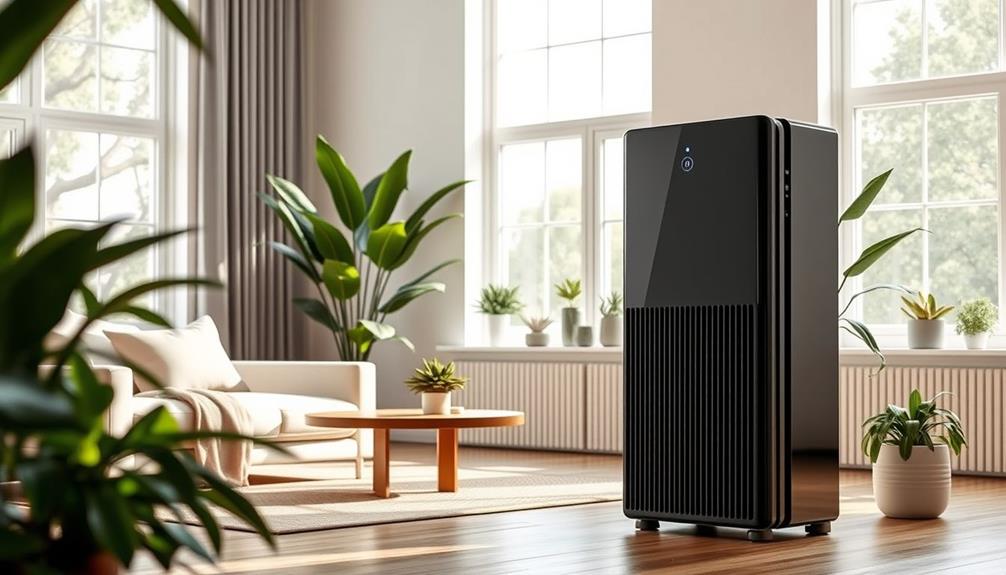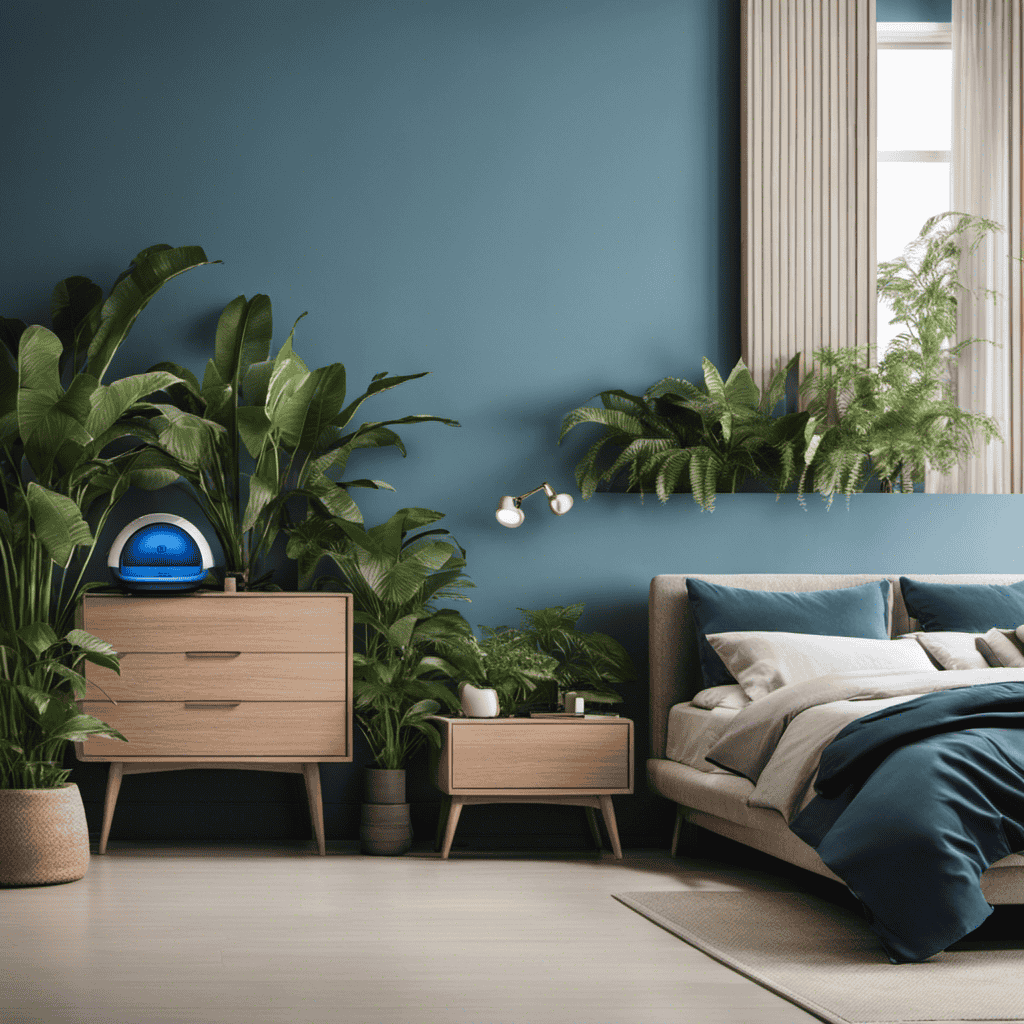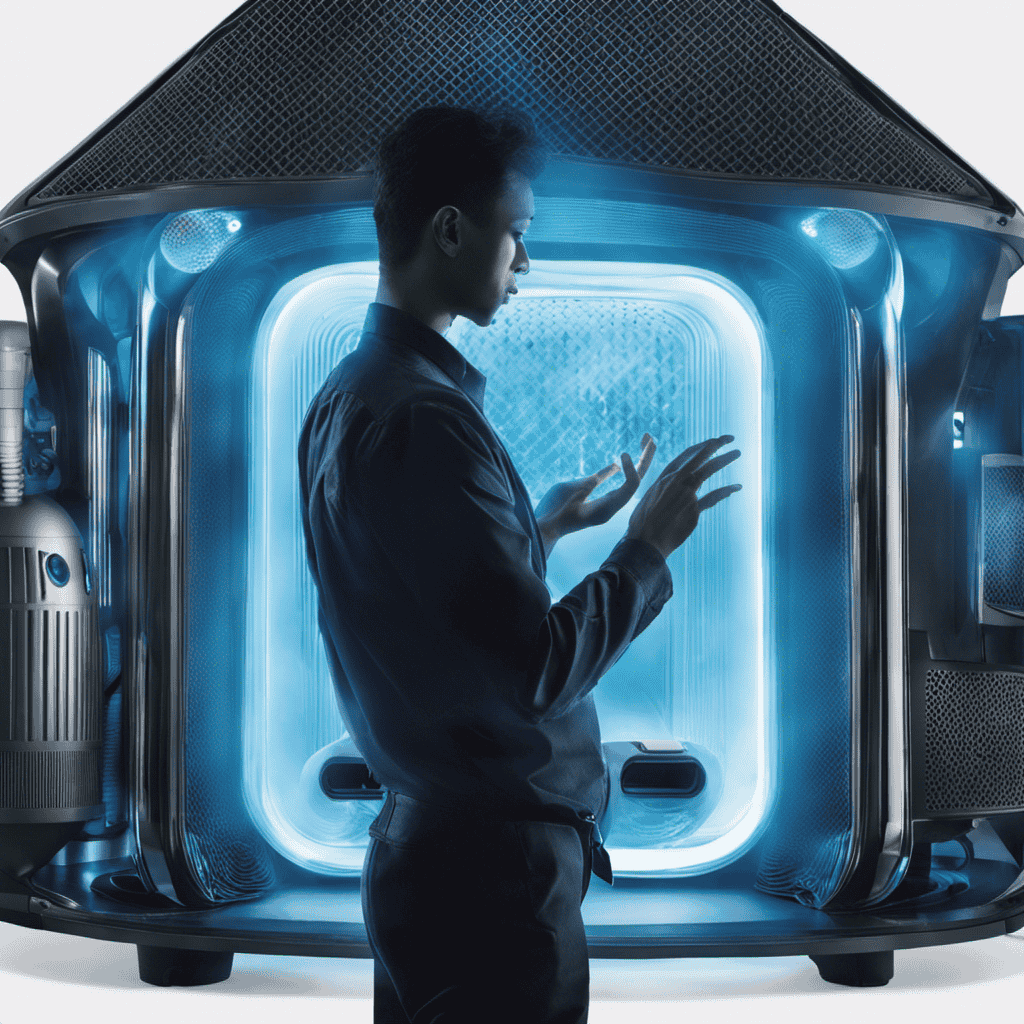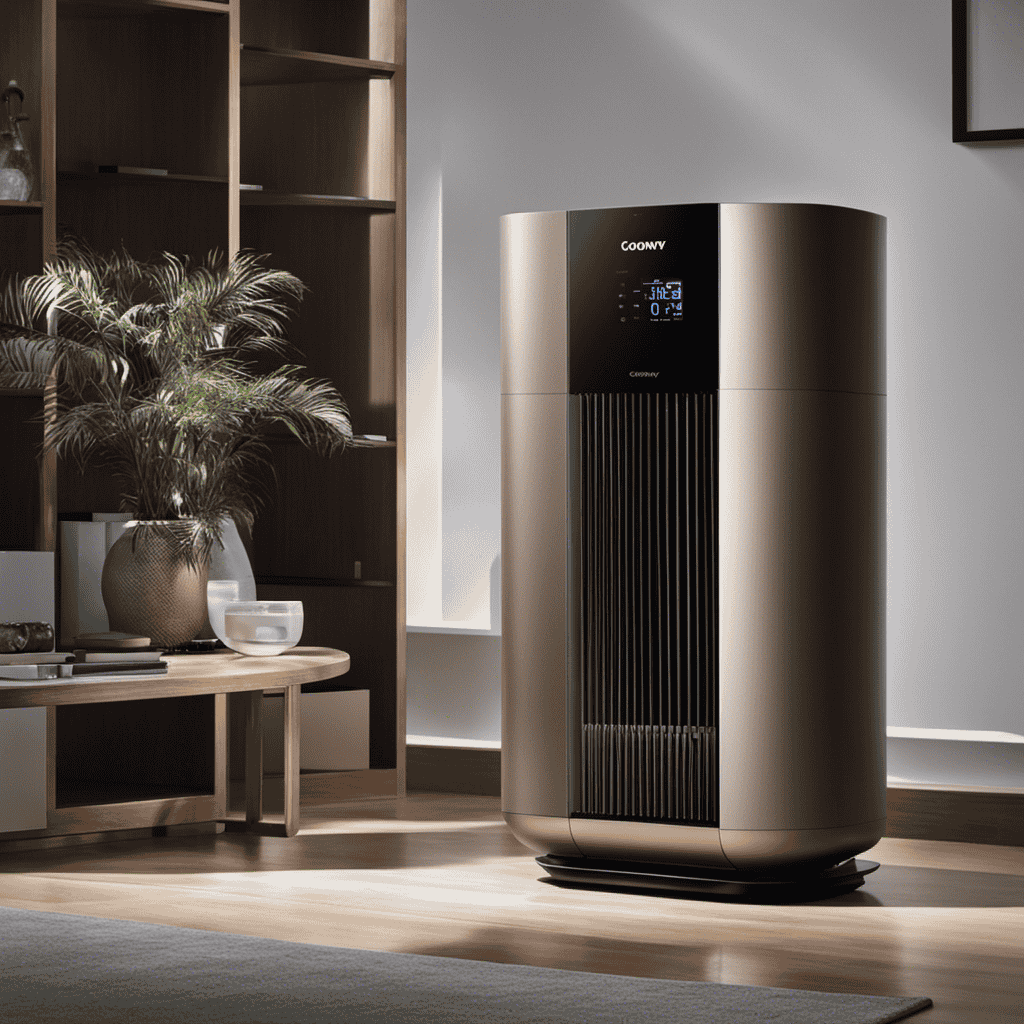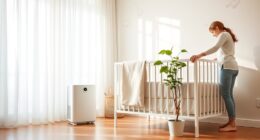The IQAir HealthPro Series is an outstanding choice for anyone looking to enhance indoor air quality. With a filtration efficiency of 99.995%, it captures particles as tiny as 0.003 microns. The HealthPro Plus model covers large spaces up to 1,125 sq. ft., making it ideal for homes, offices, or schools. Plus, its advanced three-level filtration system combats allergens and even airborne viruses like SARS-CoV-2. The user-friendly design includes an LCD display for real-time monitoring. If you're curious about its performance tests, setup, and value, there's plenty more to explore.
Key Takeaways
- The IQAir HealthPro Plus features a three-level filtration system, capturing particles as small as 0.003 microns with 99.995% efficiency.
- It effectively purifies air in spaces up to 1,125 sq. ft., making it suitable for homes, offices, and schools.
- The device is independently tested to remove airborne viruses, including SARS-CoV-2, enhancing indoor air safety.
- With a long-lasting HyperHEPA filter lasting over four years, maintenance costs are significantly reduced compared to competitors.
- The HealthPro series includes a 10-year limited warranty, ensuring long-term reliability and value for users.
Company Overview
When it comes to air quality solutions, IQAir stands out with its commitment to innovation and excellence. Founded in 1963, this Swiss-based company specializes in advanced air purification technologies that effectively improve indoor air quality. With a strong presence in over 100 countries, IQAir is recognized for its dedication to providing high-quality products that enhance your living environment.
Their air purifiers, particularly the HealthPro series, utilize sophisticated filtration systems to combat air pollution and allergens, similar to the effectiveness of other high-end models like ozone air purifiers. The HealthPro Plus air purifier is a prime example of this commitment. Designed to cover large rooms up to 1,125 square feet, it utilizes hospital-grade HyperHEPA filters that remove even the tiniest particles from the air. This impressive filtration system targets common pollutants, including allergens, dust, and airborne pathogens, ensuring you breathe cleaner air.
IQAir's products are rigorously tested in Swiss facilities, and each HealthPro Plus comes with a hand-signed Certificate of Performance, guaranteeing its quality. With an Air Quality Index that reflects superior performance, IQAir exceeds the typical warranty period, offering a 10-year limited warranty on their products.
This dedication to reliability and customer satisfaction makes IQAir a trusted name in air quality solutions, all proudly made in Switzerland.
HealthPro Plus Features
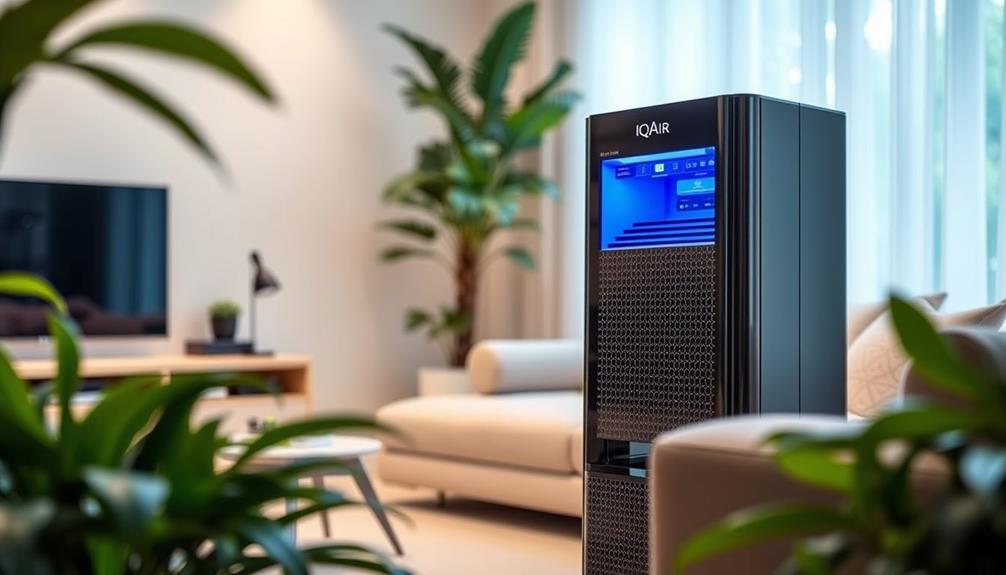
The IQAir HealthPro Plus air purifier packs a punch with its impressive features designed to enhance your indoor air quality. Covering spaces up to 1,125 square feet, it's ideal for both large and small rooms.
With the rise of remote work and increased time spent indoors, the importance of clean air has never been more critical, especially in light of recent cybersecurity disruptions that have pushed many to prioritize health in their home environments cybersecurity measures.
You'll appreciate the three-level filtration system, which includes PreMax, V5-Cell, and advanced HyperHEPA filters. This setup captures particles down to 0.003 microns, boasting a 99.5% filtration efficiency.
With six fan speeds and a maximum air flow rate of 300 cubic feet per minute (CFM), this air purifier quickly improves your environment. The HyperHEPA filter technology has been independently tested to effectively remove airborne viruses, including SARS-CoV-2, ensuring a safer atmosphere for you and your family.
User convenience is a top priority, as the HealthPro Plus comes with an LCD display that shows real-time data, color-coded filter health indicators, and a remote control for effortless operation.
When it's time for filter replacement, you'll be notified, making maintenance simple. In a world filled with pollutants, the HealthPro Plus Air Purifier stands out as a top choice among air purifiers, combining efficiency and ease of use.
Setup and Maintenance
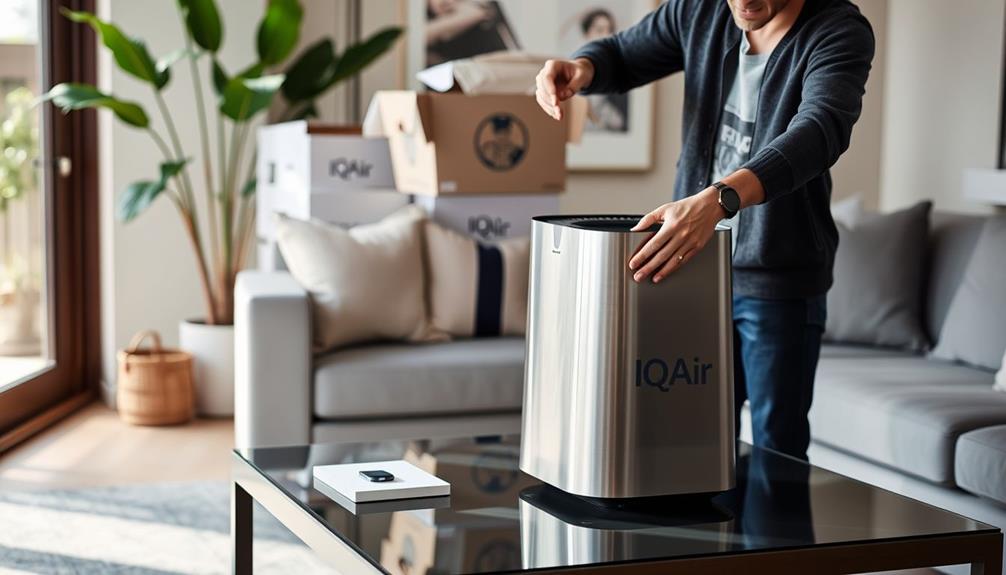
Setting up your IQAir HealthPro Plus is a breeze, requiring minimal assembly—just attach the wheels for easy mobility.
Once you've got it rolling, place the unit in a location with at least one foot of clearance all around. This guarantees ideal airflow and performance, similar to how security systems can enhance protection for your home environment.
The control panel is user-friendly, featuring an LCD display that shows fan speed settings and filter life.
You'll appreciate the color-coded LEDs, which indicate filter health: green means it's in good shape, while red signals that it's time for immediate replacement.
Regular maintenance is straightforward, thanks to the exceptional longevity of the filters. The HyperHEPA filter can last over four years with typical usage of about 10 hours a day, which means you won't be changing filters frequently.
When it's time for a replacement, you can easily find the filters from IQAir or third-party retailers. This reduces long-term maintenance costs and keeps your air purifier running efficiently.
AirVisual Pro Functionality

Monitoring air quality has never been easier with the AirVisual Pro, a powerful device that tracks essential metrics like AQI and CO2 levels in real time. This air quality monitor connects to Wi-Fi, providing you with local AQI readings and weather forecasts. You'll receive mobile alerts and suggestions to improve your air quality, ensuring you maintain a healthy environment.
The AirVisual Pro features a rechargeable battery, allowing you to monitor air quality in different rooms throughout your home. While it doesn't detect radon, it effectively identifies high CO2 levels, which can lead to fatigue and decreased concentration. Priced at $269, it complements the IQAir HealthPro series by enhancing your understanding of indoor air quality dynamics and encouraging proactive measures.
Here's a quick look at its features:
| Feature | Description |
|---|---|
| AQI Monitoring | Tracks air quality index in real time |
| CO2 Level Detection | Identifies harmful CO2 levels |
| Wi-Fi Connectivity | Provides local AQI and weather forecasts |
| Battery Life | Rechargeable for mobility |
| Alerts and Suggestions | Offers tips for cleaner air |
With the AirVisual Pro, you can take charge of your air quality and enjoy cleaner, healthier air at home.
Performance Testing
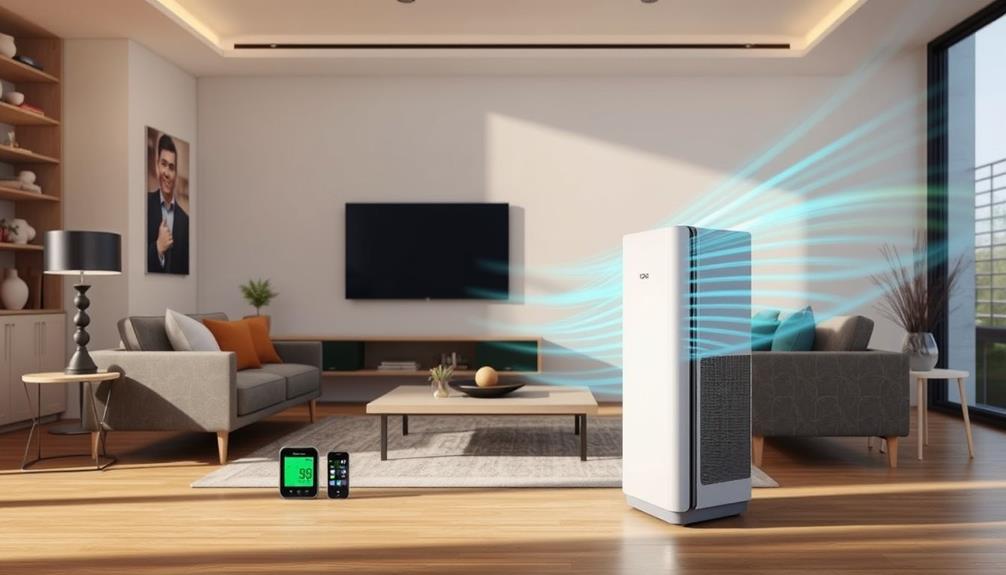
When it comes to performance testing, the IQAir HealthPro Plus air purifier truly stands out. With an impressive processing capability of approximately 300 cubic feet per minute (CFM), this unit effectively cleans the air in rooms up to 1,125 square feet. In a 150 sq. ft. test, it reduces particle concentration from 10,000 to just 1,000 in only 9 minutes.
The exceptional performance of the IQAir HealthPro Plus can be likened to the importance of diversification of retirement portfolios in enhancing financial security. Its filtration efficiency is validated by independent third-party testing, boasting a remarkable 99.995% removal rate of airborne particles down to 0.003 microns, including harmful pathogens like SARS-CoV-2.
The robust 4-inch thick HEPA filter not only enhances allergen reduction but also guarantees longevity, requiring less frequent replacements compared to competitors with thinner filters.
Real-life performance tests further demonstrate its effectiveness, greatly improving indoor air quality by reducing allergens and odors from cooking and smoke. The integrated air quality monitor reinforces these results, showcasing measurable enhancements in air quality metrics during operation.
With its advanced filtration system and high performance, the IQAir HealthPro Plus stands as a top choice for those serious about maintaining a healthy indoor environment.
Recommendations and Insights

When considering the IQAir HealthPro Plus, it's important to weigh its impressive performance testing results against your specific needs.
The addition of a high-quality air purifier can greatly enhance your overall home environment, much like how headphone amplifiers improve sound clarity for audiophiles.
You'll find that its effective air quality management features, especially when paired with the AirVisual Pro, make it a smart investment for maintaining a healthier environment.
Also, take a moment to evaluate the price versus value to ascertain it fits your budget while meeting your air purification requirements.
Performance Testing Results
Given the rigorous performance testing results, the IQAir HealthPro Plus air purifier stands out as a premier choice for anyone concerned about air quality. In a controlled test, it reduced particle concentration from 10,000 to just 1,000 in under 9 minutes in a 150 sq. ft. space, achieving an ultra-low concentration of 100 particles per cubic foot with extended use. This performance is bolstered by independent validation showing the HealthPro Plus captures 99.5% of ultrafine particles down to 0.003 microns, including harmful viruses and bacteria.
User feedback is overwhelmingly positive, especially during allergy season, with reports of no congestion even in homes with pets. The accompanying air quality monitor further proves its effectiveness, showing marked improvements in air quality metrics.
Here's a summary of the performance testing results:
| Test Metric | Initial Value | Post-Purification Value |
|---|---|---|
| Particle Concentration | 10,000 | 1,000 |
| Ultrafine Particles | 99.5% | Captured |
| Filter Lifespan | N/A | 4+ years |
| Improvement in Allergy | N/A | No congestion reported |
| Usage Recommendation | 10 hours/day | Ideal performance |
Effective Air Quality Management
The impressive performance of the IQAir HealthPro Plus air purifier highlights the importance of effective air quality management in any indoor environment. With its ability to cover large areas up to 1,125 square feet, this high-quality room air purifier is ideal for homes, offices, and schools.
It boasts a remarkable filtration efficiency of 99.995%, effectively removing allergens, bacteria, and viruses, including SARS-CoV-2. Additionally, just as heat pumps can enhance indoor climate control by efficiently transferring thermal energy, the HealthPro Plus guarantees that your air quality is consistently maintained.
By utilizing advanced filtration technology, this air purifier can considerably improve the overall indoor air experience, similar to how heat pump technology advancements optimize energy efficiency.
To enhance your air quality management, consider pairing the HealthPro Plus with the AirVisual Pro air quality monitor. This combination allows you to track air quality metrics in real-time, empowering you to take proactive measures when needed.
The unit features three filtration levels: PreMax to capture coarse particles, V5-Cell to filter odors and gases, and HyperHEPA for fine particles.
Utilizing different fan speeds can help you quickly adjust the air purifier's performance based on current air quality conditions. With long-lasting filters, including the HyperHEPA filter lasting 3.75 to 4.25 years, you can maintain effective air quality management without frequent replacements.
Prioritize your indoor air quality for a healthier living environment.
Price Versus Value Considerations
While investing in an air purifier like the IQAir HealthPro Plus may seem intimidating due to its price tag of around $899, it's essential to weigh this cost against the long-term benefits it offers. This unit stands out in a market where many options range from $100 to $500, but its value is evident when you consider its exceptional features.
Furthermore, ensuring that you protect your savings is important when making significant purchases, as the right investment can lead to greater health benefits.
The HealthPro Plus boasts a proven filtration efficiency of 99.995% for particles down to 0.003 microns, providing hospital-grade air purification. For individuals with serious health concerns, this level of filtration makes it a worthwhile investment.
In addition, the unit includes long-lasting filters, such as the HyperHEPA filter that lasts up to 4.25 years, reducing your overall maintenance costs compared to other models requiring frequent replacements.
Moreover, the 10-year limited warranty surpasses the typical 3-5 year coverage found with competitors, enhancing its long-term value.
Customer reviews consistently highlight improvements in indoor air quality during allergy and wildfire seasons, reinforcing that spending on the HealthPro Plus isn't just a purchase—it's an investment in your health and well-being.
Conclusion
In choosing the IQAir HealthPro series, you're embracing cleaner air, investing in your health, and enhancing your home environment. You're not just getting an air purifier; you're gaining peace of mind, ensuring your family's well-being, and taking a stand against pollutants. With its impressive features, easy maintenance, and reliable performance, the HealthPro series becomes more than a device—it's a commitment to quality living. So, breathe easier, live better, and enjoy the fresh air you deserve.
